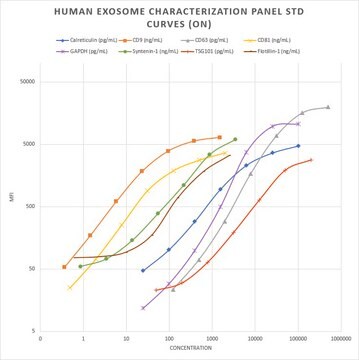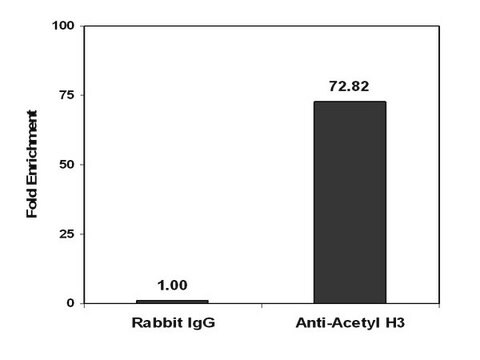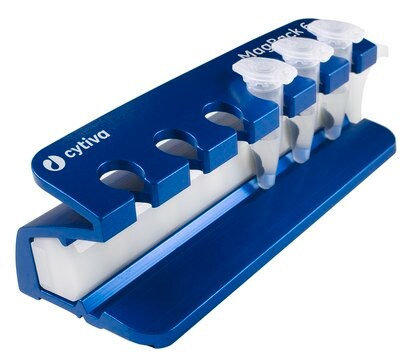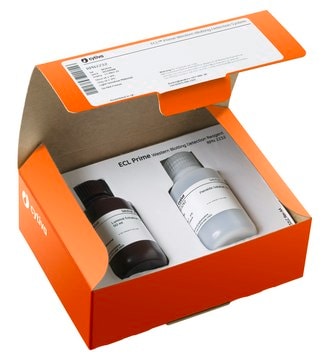HEXSM-170K-BKPMX
MILLIPLEX® Human Exosome Characterization Panel
for analysis of multiple analytes isolated from serum, plasma and tissue culture supernatants
About This Item
Productos recomendados
Nivel de calidad
Línea del producto
Milliplex®
reactividad de especies
human
envase
pkg of 96 wells
assay range
standard curve range: 0.4-1,500 ng/mL
(CD9)
standard curve range: 0.5-2,000 ng/mL
(CD81)
standard curve range: 122-500,000 pg/mL
(CD63)
standard curve range: 1: 0.6-2,500 ng/mL
(Flotillin)
standard curve range: 1: 0.9-3,500 ng/mL
(Syntenin)
standard curve range: 24-100,000 pg/mL
(Calreticulin, GAPDH)
standard curve range: 49-200,000 pg/mL
(TSG101)
inter-assay cv: <20%%
intra-assay cv: <10%
técnicas
multiplexing: suitable
método de detección
fluorometric (Luminex® xMAP®)
Descripción general
Each MILLIPLEX® kit includes:
- Quality controls (QCs) to qualify assay performance
- Comparison of standard (calibrator) and QC lots to a reference lot to ensure lot-to-lot consistency
- Detection antibody cocktails designed to yield consistent analyte profiles within panel
Panel Type: MAGNETIC Circulating Cancer
Especificidad
Aplicación
- This is an overnight assay.
- Each assay requires 25 µL per well of isolated exosomes.
- Argonaute-2 (Ago2) is a qualitative assay with the MCF7:IGF-1 Cell Lysate included as a control. All other analytes are for quantitative analysis.
- To test purity of EV preparation, the MILLIPLEX® Human Apolipoprotein 6-Plex Panel (Cat. No. APOMAG-62K) can be used.
- To asses the functional component of EVs, the MILLIPLEX® Human Cytokine/Chemokine Growth Factor Panel A (Cat. No. HCYTA-60K), Panel B (HCYTB-60K), and Multi-Species TGFβ Panel (Cat. No. TGFBMAG-64K-03) can be used.
- Following sample collection and preparation, exosomes can now be isolated and lysed according to your lab’s established protocol. We recommend Cell Signaling Lysis Buffer (Cat. No. 43-040).
- Each lab may use its preferred lysis buffer but must predetermine that the assay will not be negatively affected by the lysis buffer.
Envase
Almacenamiento y estabilidad
Otras notas
Información legal
Cláusula de descargo de responsabilidad
Palabra de señalización
Danger
Frases de peligro
Consejos de prudencia
Clasificaciones de peligro
Acute Tox. 4 Dermal - Acute Tox. 4 Inhalation - Acute Tox. 4 Oral - Aquatic Acute 1 - Aquatic Chronic 2 - Eye Dam. 1 - Skin Irrit. 2 - Skin Sens. 1 - STOT RE 2
Órganos de actuación
Respiratory Tract
Código de clase de almacenamiento
10 - Combustible liquids
Clase de riesgo para el agua (WGK)
WGK 3
Certificados de análisis (COA)
Busque Certificados de análisis (COA) introduciendo el número de lote del producto. Los números de lote se encuentran en la etiqueta del producto después de las palabras «Lot» o «Batch»
¿Ya tiene este producto?
Encuentre la documentación para los productos que ha comprado recientemente en la Biblioteca de documentos.
Nuestro equipo de científicos tiene experiencia en todas las áreas de investigación: Ciencias de la vida, Ciencia de los materiales, Síntesis química, Cromatografía, Analítica y muchas otras.
Póngase en contacto con el Servicio técnico












